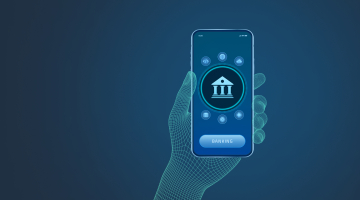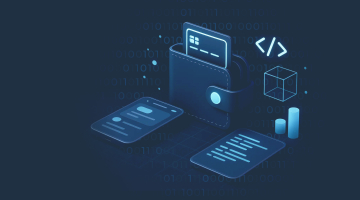
Payment app development: Main benefits and features
The contemporary tech-savvy world is essentially a mobile-driven one. Nowadays, our smartphones have stopped being simple communication media and have become multi-functional instruments we leverage to work, study, shop, and have fun. The ability to pay for products and services we enjoy is also increasingly delegated to our gizmos thanks to mobile payment applications installed on them.
This article digs into the types and features of mobile payment apps, showcases the benefits of bespoke mobile payment app development, highlights the challenges software engineers face during the development process, and offers a universal algorithm that will allow you to create a successful payment app in 2025.
An overview of the mobile payment application development niche
The major fintech trend in the early third millennium is the gradual decline of the existing banking infrastructure and traditional financial institutions accompanied by the advent of neobanks. It is the telltale sign of the rapid transition to the cashless paradigm, which involves broad leveraging of peer-to-peer (P2P) payment apps honed for digital payments and online money transfers.
Instead of carrying along bulky physical wallets and numerous credit cards in their pockets, people prefer to perform all financial transactions via digital wallets nestling in their mobile devices. Apple Pay, Alipay, PayPal One Touch, Google Pay, Cash App, Samsung Pay, and other mobile payment systems launched by payment service providers enable users to pay bills, accept payments, transfer funds to and from their bank accounts, and more with a just few taps on their device’s screen.
Given the ubiquity of smartphones, the spread of e-commerce, and the convenience of using such payment gateways, it is no wonder that the global value of transactions in this sector has reached $20.37 trillion this year (where China is setting the pace with $12.65 trillion) and is projected to approach $37 trillion by 2029 manifesting a spectacular CAGR of 15.9%. The corresponding market size is likely to display a twice that big CAGR by 2030 and equal $18.84 billion.
Forward-looking financial organizations can’t miss such mouth-watering revenue prospects and respond by launching their money transfer apps and mobile platforms. If you want to stay ahead of the technological curve in the field and outstrip your rivals in the cut-throat competition symptomatic of the contemporary financial realm, crafting a custom online payment app is not a matter of choice but a vital necessity. And the first step to make in this way is to understand what kind of digital payment app you are going to build.
Types of P2P payment apps
Before getting to grips with the classification, let’s find out what a P2P app is. As the name suggests, this software enables people to perform peer-to-peer payments, that is, it serves for transferring money between bank accounts. Its core element is a secure and reliable payment gateway allowing fast money transfers. Depending on the app’s integration into a broader ecosystem and its functions, such solutions fall into five basic types.
P2P payment app types
Standalone payment apps
They rely on their own payment processing system to conduct transactions, offering users standalone services and allowing them to accumulate, send, and receive money through this dedicated app.
Bank-centric payment apps
Such products are launched by banks to streamline and facilitate transactions for their clientele. Sometimes, the target audience of such apps is limited to the customers of a single institution, whereas others are developed by several banks in cooperation (like Zelle, which caters to the clientele of Trust, JPMorgan Chase, Bank of America, Capital One, and other US-based financial organizations).
Social media-centric systems
Many solid social media offer their users payment processing networks (SnapCash, Facebook Pay, Square Cash) to let them transfer money without leaving the platform once they connect their bank account or credit card to the social media app. Or, as is the case with WhatsApp’s payment processor, app users can exchange money via a QR code or UPI ID.
Mobile OS-focused platforms
These utilize intrinsic hardware capabilities (like NFC) built into the device’s operating system – Android (Android Pay) or iOS (Apple Pay). Their main forte is the utmost cyber security implemented on the OS level.
Foreign exchange payment apps
Such mobile apps are especially useful in cross-border money transfers, allowing people to send money in one national currency and receive it in another. Wise, as an example of such applications, won universal acclaim among users since it supports 25 currencies and is wise enough (the pun is intentional) to offer lower transaction fees for currency exchanges in comparison to banks.
When you know what kind of product you need, it is time to determine payment app features.
Must-have features of payment gateway apps
As a seasoned vendor specializing in money transfer app development, DICEUS is aware of the non-negotiable functionalities an average payment app should include.
Payment app features
Multi-factor user authentication
The greatest concern of people and organizations using fintech products is the safety of sensitive financial data and payment details. To guarantee it, secure payment apps should rely on one-time passwords, unique IDs, and at least two-factor authentication (preferably including a fingerprint lock, a voice recognition mechanism, or retinal image verification) that will exclude launching the app by unauthorized people and prevent accidental access to personal and credit card data.
Digital wallet
This is the bedrock of the app through which funds are stored, requested, transferred, and withdrawn in real time. To provide an exclusive customer experience, the wallet should enable recurring, split, and advance payments in multiple currencies (major cryptocurrencies included) and support versatile multiple payment options (QR-code-based and NFC-enabled payments as well). Besides, by integrating Visa and Mastercard payment tokenization services, you will cover most banks and financial institutions worldwide.
Send and receive funds
Such transactions are the key operations utilized by app users. You should equip the app with the ability to transfer money via the recipient’s phone number, email address, or account ID.
Billing and invoicing
This feature allows individuals and organizations to verify money-transferring operations and initiate payment collection. Make sure your app offers bill/invoice generation in several popular formats, like PDF, in-app, and email-centric.
Banking integration
P2P money transfers are the staple of payment apps. However, the ability to send funds to bank accounts is a welcome functional addition valued by users.
Transaction history
A high-quality P2P payment app enables customers to keep track of their past transactions, thus controlling inflows and outflows and staying in the know of their current balance. This functionality should be equipped with filters containing custom data range, smart sorting, and other payment information to let them find the necessary transaction details in a New York minute. Besides, they should be able to share transaction history across various messengers and apps, download it, and print it out in PDF format.
Spending analytics
This feature offers a collection of insights concerning the app user’s expenses over a selected period (a week, a month, a quarter), helping them analyze their payment data, categorize transactions, plan future expenses, and foster responsible spending habits.
Currency converter
Making cross-border transfers and paying for products and services abroad is impossible without automated currency conversion. It is enabled via the integration of specialized exchange rate APIs that come into play each time you make a transaction requiring currency conversion.
Text messaging
This module is especially useful for lending and social-oriented initiatives to let customers attach details and comments to the transfer they make. It can be upgraded to function as an in-app chat and provide a reliable communication channel with fellow users.
Push notifications and alerts
This is not only an instrument for keeping the users abreast of their financial transactions, debits, credits, receipts, and other fund movements or warning them about suspicious activities related to their accounts. They serve as an excellent marketing channel, allowing the app owner to inform customers about updates, special offers, promotions, and new releases the financial organization launches.
Customer support
Today, it is usually implemented via an AI-powered chatbot and access to the knowledge base. This helps app users navigate the app’s intricacies and enables them to solve technical or transactional problems that may crop up during the app’s operation.
All these features are found in garden-variety products in this realm. If you want to expand this roster and add unique functionalities, you should consider custom P2P payment app development.
Benefits of bespoke payment apps
What do banks and their clients get by opting for tailor-made payment apps?
benefits of custom payment apps
Flexibility and scalability
In contrast to off-the-shelf solutions that are carved in stone, bespoke products are flexible enough to meet the owner’s unique business and technical requirements. They can be built with an eye to the future expansion of the client base, service scope, transaction volume, or adaptation to emerging technologies.
Integration with existing software
Every financial institution has a digital ecosystem with a unique infrastructure, CRM and ERP systems, special analytics tools, and the like. Canned payment apps may have issues with integration into the already established IT environment, causing operational inadequacies and data silos.
Custom apps can seamlessly synchronize with all infrastructure elements to form a closely-knit, high-performing system.
Enhanced security and fraud prevention
In the fintech realm, strong security is the name of the game. Customers must be 100 percent sure their personal and financial data is leakage-proof, whereas financial organizations must guarantee such protection and forestall fraud. Off-the-shelf products are equipped with standard security mechanisms and protocols that may not satisfy the high requirements of brands that value their business reputation and their clientele’s safety. With bespoke payment apps, the sky is the limit for implementing as many reliable security and fraud prevention best practices as possible.
Embracing innovation
Building a custom app, you can integrate any cutting-edge technology (artificial intelligence, blockchain, machine learning, cloud services, IoT, you name it) to elevate its functionalities to a new level and keep abreast of the latest achievements in the technological field. Moreover, you keep the door open for harnessing new payment models that create new sources of revenues and augment user audience.
Personalization of user experience
Knowing your current and potential users inside out, you can fine-tune your payment app to resonate with all customer categories. Its intuitive interface and extensive functionality roster can be crafted to dovetail with their payment habits and preferences, thus meeting your clientele halfway in catering to their needs, increasing customer satisfaction, and promoting brand loyalty.
Tapping niche markets
Being honed for an average financial institution’s goals and audience, off-the-shelf payment software may turn out to be a misfit for smaller banks operating in developing countries or servicing underprivileged communities. By developing a custom app, you can envisage such use cases and tweak the product correspondingly, ensuring its inclusivity and expanding consumer base.
Gamification options
Payment apps aren’t entertainment products, but some gamification elements are welcome in them to improve user engagement. With a bespoke app, you can choose any methods (rewards, achievements, point collections, progress bars, etc.) that boost customers’ interest and make it fun to interact with.
Cost-efficiency
Since a tailor-made app is a big-ticket item in comparison with generic solutions, this upside doesn’t seem obvious. Yet, when you commission a custom app, you pay only once and run it indefinitely, enjoying the constant stream of revenues it brings to your company’s coffers. Although initially cheaper, boxed solutions often require license renewals, extensions, add-ons, upgrades, and other modifications that can amount to a pretty penny down the line. So, in the long run, by opting for bespoke payment apps development, you end up in the black.
If you think that a custom P2P payment app is what the doctor ordered for your financial institution, you should understand the nuts and bolts of its development.
How to build a payment app: An algorithm to stick to
When crafting bespoke fintech apps, we at DICEUS follow a straightforward roadmap.
steps to build a payment app
Step 1. Discovery phase
Meeting the customer’s representatives for the first time, we clarify the company’s business goals and policies, its vision regarding the future product’s mission, and the features they would like to fill it with.
Step 2. Market and technical research
With all project requirements on the table, we dig deep into the topic, studying the current situation in the industry in general and the product niche in particular. Our experts expose major market trends, compare similar existing solutions, and reveal their pros and cons to understand where the new app can outstrip them. Also, they get to grips with technological challenges related to security, compliance, integration, etc., which will have to be addressed during the SDLC.
Step 3. Choosing the app type
Out of the five app types (see above), we select one that is called to attain the company’s business goals and aligns with its values.
Step 4. Dissecting the target audience
It is mission-critical to know the people who will use your app the whole nine yards. To keep on the same page with them, we conduct feasibility studies, hold interviews, and run surveys, discovering consumers’ attitudes to certain functionalities the app will contain. The major deliverable of this stage is a 360-degree picture of the prospective user with their demographics, preferences, needs, expectations, habits, and pain points.
Step 5. Establishing the monetization strategy
The payment app is not a charity issue but a revenue-generating initiative. The simplest way to let it earn money is to make it a paid product, but it will put the app at a disadvantage compared to competitor software of this kind, which is conventionally free to download. Our vetted consultants will advise you on the choice of other mechanisms (subscriptions, in-app ads, referral fees, freemium model, etc.) to capitalize on your product or come up with a balanced combination of several monetization techniques that suits your use case perfectly.
Step 6. Taking thought for compliance
Fintech software necessitates a security-first approach to its creation. That is why we ensure the future app’s compliance with GDPR, SEC, FINRA, and other regulations relevant to the industry and acquire the PCI DSS certificate to boost consumer trust and operational transparency.
Step 7. Determining the tech stack
At this stage, the first thing to do is to opt for the operating system (Android, iOS, or cross-platform). This choice essentially conditions frameworks, tools, and programming languages to be leveraged in the SDLC. Besides, we single out state-of-the-art technologies (AI, ML, blockchain, etc.) that the app-to-be will house.
Step 8. Appointing project team members
A typical crew for handling such initiatives includes competent selected technologies professionals: a back-end developer, a front-end specialist, a UI/UX designer, a QA engineer, and a project manager to coordinate and supervise their efforts. If the project scope goes beyond average, extra expertise is summoned to step into the breach.
Step 9. Creating a prototype and an MVP
The project’s first tangible deliverable is a clickable prototype showcasing the app’s overall logic, structure, and design. The prototype is then upgraded to become a minimum viable product (MVP), which is submitted for trial usage by the pilot audience.
Step 10. UI/UX design
The trial audience’s feedback is collected and processed, with the results becoming key guidelines for crafting the app’s client side. Then, the designers put their noses to the grindstone, creating app screen layouts, buttons, color scheme, and other UI elements. The seamless UX is ensured by devising smooth user flows and customer journey maps and optimizing user interaction with different app components.
Step 11. Back-end development
To create the app’s server side, developers perform lots of coding and align the newly built back-end elements with front-end components. Then, they implement a network of APIs to enable the product’s seamless interaction with third-party services and resources.
Step 12. QA and testing
The app development being completed, it undergoes an out-and-out testing procedure comprising usability, functional, stress, compatibility, performance, penetration, and other kinds of checks. After all the bugs and glitches are disposed of, the app is deployed and goes live.
Step 13. Maintenance and support
As a responsible software vendor, DICEUS stays with its customers during the post-launch period. Our specialists monitor the app’s performance, tackle issues, fix teething problems, and provide advice and recommendations concerning the effective usage of the product.
While building a payment app, you should learn to overcome some typical barriers during the SDLC.
Major payment application development challenges
DICEUS has a long history of delivering high-end solutions for the fintech industry that lets us single out the most frequent pitfalls and bottlenecks developers encounter in their projects.
Data security
Apps operate tons of customers’ personal and financial data, and app users want to be sure sensitive information stays secret from unauthorized persons. Developers should see to it that the payment gateway in their product is reliable and penetration-proof while the access to the app is protected via strong authentication mechanisms.
Regulatory compliance
The banking and fintech sectors are among the most heavily regulated ones, with dozens of standards safeguarding the inviolability of customer data. That is why you should ensure compliance with PCI DSS and other industry laws (both national and international) and maintain strict adherence to the anti-money-laundering legal framework (KYC regulations).
Fraud prevention
Since billions of dollars are funneled through financial operations, they are a coveted prize for fraudsters of all kinds. Organizations launching payment apps should envisage robust proactive measures to forestall such activities, identify them if they occur, and nip them in the bud.
Future-proofing
While designing the app, it is vital to understand that the IT realm doesn’t stay put. New technologies crop up regularly and push the envelope in the domain, urging tech-savvy companies poised to live up to customer expectations to harness them. The same is true of new payment methods and instruments that disrupt the financial sector. Besides, organizations in this field go through various changes related to their size, range of services, volume of user audience, etc.
All that said, payment app developers should build for scalability, rely on microservices architecture, implement a separate calculation module that will minimize the burden on the core payment system, and make provisions for potential technological upgrades and payment method innovations.
Given the multitude and scope of tasks to be handled during P2P payment app development, it is obvious that financial institutions have neither the experience nor the talent to implement such projects. DICEUS’s qualified and certified software engineers are ready to lend a helping hand. They possess in-depth industry knowledge and relevant IT expertise to deliver the best-in-class payment app solutions. Contact us to enjoy a secure P2P app that will impress users with a sleek design and smooth performance.
Estimate project costs
Please share more details of your project with our team.

Key takeaways
The fintech industry is developing at a neck-break pace, ushering in multiple software products that cater to the needs of tech-savvy consumers. P2P payment apps of different kinds (standalone, bank-centric, social media-centric, mobile OS-focused, or foreign exchange payment systems) are among the most-wanted solutions in this niche, enabling users to send and receive money from other individuals.
By building a custom payment app, financial organizations can fill it with the functionalities (user authentication, digital wallet, billing and invoicing, spending analytics, text messaging, currency converter, and more) that suit their target audience and align with business goals. Bespoke apps are scalable and flexible products that integrate seamlessly with the bank’s digital ecosystem and offer users secure and innovative instruments that cater to their financial needs, providing them with a personalized customer experience.
To craft a tailored payment app, you should hire a seasoned app development company that will follow a well-thought-out roadmap for its creation and bypass the roadblocks that stand in the way of its building.
Frequently asked questions
What are the essential features of a payment app?
A garden-variety P2P payment app offers users such functionalities as multi-factor authentication, digital wallet, funds sending and receiving, banking integration, billing and invoicing, transaction history, spending analytics, currency converter, text messaging, push notifications, and customer support. You can expand this roster by adding the features you like in a tailor-made application.
How do payment apps enhance transaction security?
To guarantee the security of customer funds and personal information, payment apps implement reliable gateways that comply with industry standards, leverage encryption and tokenization as data security mechanisms, employ robust authentication techniques, practice chargeback management and other fraud prevention measures, and update their products regularly.
What benefits do custom payment apps offer to users and businesses?
By opting for bespoke payment app development, you obtain an extra-secure, flexible, and scalable product that plays well with your existing IT ecosystem and is open to innovative upgrades. You can fill it with unique functionalities, helping you personalize user experience, engage the target audience with gamification techniques, and tap niche markets.
What are the future trends in payment app development?
The emerging trends in payment app development include the rapid growth of AI-based technologies, the advent of unconventional payment channels (like via social media or IoT devices), embracing bank-fintech partnership on a large scale, the expansion of Buy Now, Pay Later (BNPL) model, the increasing role of crypto currencies, and broad usage of behavioral biometrics for fraud detection.





